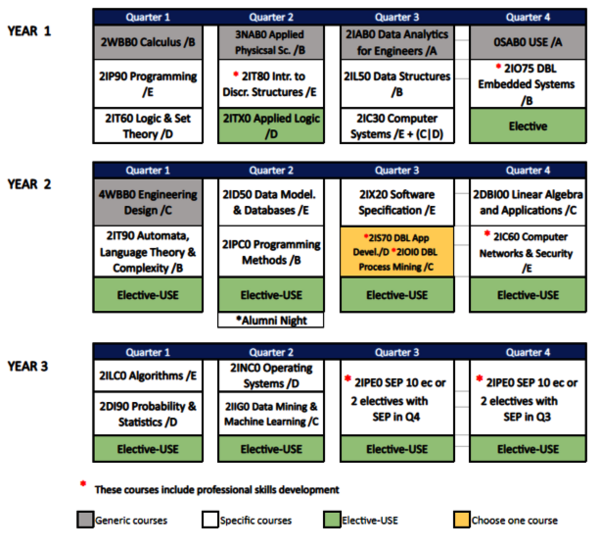Program objectives
The overall objective of the bachelor’s degree program is to train and educate young professionals to the level they need to enter an appropriate master’s degree program or embark upon a professional career in the computer science field.
To that end, you are expected to:
- Acquire cognitive skills relating to computer science and engineering
- Acquire practical capabilities and skills relating to software design
- Acquire professional and generic academic skills
A detailed descriptions of the learning outcomes of the program is presented in this profile.
Learning lines
This Bachelor program contains courses from several learning lines, which are:
- Theory and Algorithms
- Software Development
- Architecture and Networks
- Information Systems
- Web Technology and Data Mining
Program Overview 2022-2023
The schedule below provides a detailed overview of the Bachelor’s Program of Computer Science and Engineering for students starting the academic year 2022/2023. Students starting before this academic year can find their curriculum under Curriculum Archive, or in the Program and Examinations Regulations.
For all generations: One is free to choose the formal variant of basic course 3NAB0 (Yr 1, Q2): 3NBB0
For all generations: Years 2 and 3 show 10x elective or USE. This means that the student must choose between an elective study component or a USE study component. The requirement is that, in study years 2 and 3, a total of 3 USE study components (one coherent USE package) and 7 electives must be completed.
For generation 2018 and before: during the major one has to choose one DBL out of three (the other DBL’s might be chosen as electives in year 2 or 3).
For generation 2019 and onwards: during the major one has to choose one DBL out of three. The amount of DBLs is limited to 1 (see complete regulations in the PER).
For all generations: Component 2IPE0 (Yr 3,Q4) can be taken in Q1 or Q3 instead. The Q1 and Q3 instances will only be availalbe if enough students register to form a group.

Timeslots
To prevent scheduling mix-ups, each course falls into a timeslot. Use these timeslots to create a feasible schedule that allows you to follow all lectures and tutorials and take all exams.
Career Orientation
Here is more information about Career Orientation.
Directly to
More information
Want to know more? Contact M&CS Education and Student Affairs at +31 40 - 247 2379 or via the contact form below.